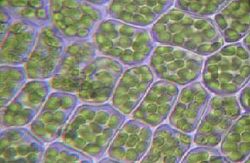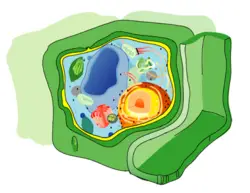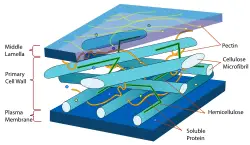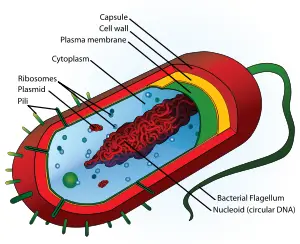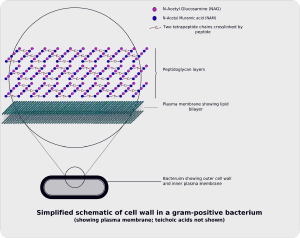Difference between revisions of "Cell wall" - New World Encyclopedia
Rick Swarts (talk | contribs) |
Rick Swarts (talk | contribs) |
||
| Line 34: | Line 34: | ||
Plant cell walls vary from 0.1 micrometers (µm) to many micrometers in thickness (Alberts et al. 1989). | Plant cell walls vary from 0.1 micrometers (µm) to many micrometers in thickness (Alberts et al. 1989). | ||
| − | The major [[carbohydrate]]s making up the primary (growing) cell wall are [[cellulose]], [[hemicellulose]], and [[pectin]]. The cellulose [[microfibril]]s are linked via hemicellulosic tethers to form the cellulose-hemicellulose network, which is embedded in the pectin matrix. The most common hemicellulose in the primary cell wall is [[xyloglucan]]. In grass cell walls, xyloglucan and pectin are reduced in abundance and partially replaced by [[glucuronarabinoxylan]], a hemicellulose. Primary cell walls characteristically extend (grow) by a mechanism called [[acid growth]], which involves [[turgor]]-driven movement of the strong cellulose microfibrils within the weaker hemicellulose/pectin matrix, catalyzed by [[expansin]] proteins. | + | The ''primary cell walls'' of plants vary greatly in composition and organization, but basically are constructed from long fibers held together by a matrix of [[protein]] and polysaccharide (Alberts et al. 1989). The major [[carbohydrate]]s making up the primary (growing) cell wall are [[cellulose]], [[hemicellulose]], and [[pectin]]. The cellulose [[microfibril]]s are linked via hemicellulosic tethers to form the cellulose-hemicellulose network, which is embedded in the pectin matrix. The most common hemicellulose in the primary cell wall is [[xyloglucan]]. In [[grass]] cell walls, xyloglucan and pectin are reduced in abundance and partially replaced by [[glucuronarabinoxylan]], a hemicellulose. Primary cell walls characteristically extend (grow) by a mechanism called [[acid growth]], which involves [[turgor]]-driven movement of the strong cellulose microfibrils within the weaker hemicellulose/pectin matrix, catalyzed by [[expansin]] proteins. |
The major [[polymer]]s that make up wood (largely secondary cell walls) include cellulose (35 to 50%), [[xylan]], a type of hemicellulose, (20 to 35%) and a complex phenolic polymer called [[lignin]] (10 to 25%). Lignin penetrates the spaces in the cell wall between cellulose, hemicellulose and pectin components, driving out water and strengthening the wall. Secondary walls - especially in grasses - may also contain microscopic silicate crystals, which may strengthen the wall and protect it from herbivores. | The major [[polymer]]s that make up wood (largely secondary cell walls) include cellulose (35 to 50%), [[xylan]], a type of hemicellulose, (20 to 35%) and a complex phenolic polymer called [[lignin]] (10 to 25%). Lignin penetrates the spaces in the cell wall between cellulose, hemicellulose and pectin components, driving out water and strengthening the wall. Secondary walls - especially in grasses - may also contain microscopic silicate crystals, which may strengthen the wall and protect it from herbivores. | ||
| Line 45: | Line 45: | ||
*The '''[[secondary cell wall]]''', a thick layer formed inside the primary cell wall after the cell is fully grown. It is not found in all cell types. In some cells, such as found [[xylem]], the secondary wall contains [[lignin]], which strengthens and waterpoofs the wall. | *The '''[[secondary cell wall]]''', a thick layer formed inside the primary cell wall after the cell is fully grown. It is not found in all cell types. In some cells, such as found [[xylem]], the secondary wall contains [[lignin]], which strengthens and waterpoofs the wall. | ||
| − | Cell walls in some plant tissues also function as storage depots for carbohydrates that can be broken down and resorbed to supply the metabolic and growth needs of the plant. For example, endosperm cell walls in the seeds of cereal grasses, nasturtium, and other species, are rich in glucans and other polysaccharides that are readily digested by enzymes during seed germination to form simple sugars that nourish the growing embryo. Cellulose microfibrils are not readily digested by plants, however. | + | Cell walls in some plant tissues also function as storage depots for carbohydrates that can be broken down and resorbed to supply the metabolic and growth needs of the plant. For example, endosperm cell walls in the seeds of cereal grasses, nasturtium, and other species, are rich in glucans and other polysaccharides that are readily digested by enzymes during seed germination to form simple sugars that nourish the growing embryo. Cellulose microfibrils are not readily digested by plants, however. |
=== Formation === | === Formation === | ||
Revision as of 19:42, 10 July 2008
A cell wall is a fairly rigid layer surrounding, outside the cell membrane, the cells of plants and certain bacteria, archaea (archaebacteria), fungi, and algae. This extracellular matrix is characteristically absent from animal cells, although animal cells have extracellular matrix components on their surface (Alberts et al. 1989). Most protists also lack cell walls.
Cell walls provide structural support, protection, and act as a filtering mechanism. The cell wall also prevents over-expansion when water enters the cell. Most differences between plants and animals, including in motility, nutrition, growth, and reproduction, can be traced to the relatively rigid plant cell wall (Alberts et al. 1989).
The materials in a cell wall vary between species. In plants, the strongest component of the complex cell wall is a carbohydrate polymer called cellulose. In bacteria, peptidoglycan forms the cell wall. Archaea have various chemical compositions, including glycoprotein S-layers, pseudopeptidoglycan, or polysaccharides. Fungi possess cell walls of chitin, and algae typically possess walls constructed of glycoproteins and polysaccharides; however certain algal species may have a cell wall composed of silicic acid. Often, other accessory molecules are found anchored to the cell wall.
Properties
The cell wall serves a similar purpose in those organisms that possess them. The wall gives cells rigidity and strength, offering protection against mechanical stress. In multicellular organisms, it permits the organism to build and hold its shape (morphogenesis). The binding together of adjacent cell walls results in the cells of a plant being cemented together, forming the intact plant (Alberts et al. 1989). The cell wall also limits the entry of large molecules that may be toxic to the cell. It further permits the creation of a stable osmotic environment by preventing osmotic lysis and helping to retain water. The composition, properties, and form of the cell wall may change during the cell cycle and depend on growth conditions.
Rigidity
In most cells, the cell wall is semi-rigid, meaning that it will bend somewhat rather than holding a fixed shape. This flexibility is seen when plants wilt, so that the stems and leaves begin to droop, or in seaweeds that bend in water currents. Wall rigidity seen in healthy plants results from a combination of the wall construction and turgor pressure. As stated by Howland (2000):
| “ | Think of the cell wall as a wicker basket in which a balloon has been inflated so that it exerts pressure from the inside. Such a basket is very rigid and resistant to mechanical damage. Thus does the prokaryote cell (and eukaryotic cell that possesses a cell wall) gain strength from a flexible plasma membrane pressing against a rigid cell wall. | ” |
The rigidity of the cell wall thus results in part from inflation of the cell contained. This inflation is a result of the passive uptake of water.
Other cell walls are inflexible. In plants, a denser, less hydrated secondary cell wall is produced either from a thickening of the primary wall by adding more layers of cellulose (generally molecules of longer size) or depositing layers of a different composition inside the cell wall (Alberts et al. 1989). Additional layers may be formed containing lignin in xylem cell walls, or containing suberin in cork cell walls. These compounds are rigid and waterproof, making the secondary wall stiff. Both wood and bark cells of trees have secondary walls. Other parts of plants, such as the leaf stalk, may acquire similar reinforcement to resist the strain of physical forces.
Certain single-cell protists and algae also produce a rigid wall. Diatoms build a frustule from silica extracted from the surrounding water; radiolarians also produce a test from minerals. Many green algae, such as the Dasycladales, encase their cells in a secreted skeleton of calcium carbonate. In each case, the wall is rigid and essentially inorganic.
Permeability
The rigid cell limits the exchange of molecules between the cell interior and its environment and restricts interaction and communication between cells (Alberts et al. 1989). Nonetheless, the primary cell wall of most plant cells is semi-permeable and permits the passage of small molecules and small proteins, with size exclusion estimated to be 30-60 kDa. Key nutrients, especially water and carbon dioxide, are distributed throughout the plant from cell wall to cell wall in apoplastic flow.
Special channels connect the cytoplasm of neighboring plant cells, allowing the controlled passage of ions and small molecules. In vascular plants, cylindrical cells are connected end to end, resulting in long columns through which water and nutrients can flow (Alberts et al. 1989).
Plant cell walls
The presence of a rigid cell wall is one of two major differences that distinguish plants from animals, the other being the ability to fix carbon dioxide by photosynthesis (Alberts et al. 1989). The presence of rigid cells walls means that multicellular plants have a nonmotile life-style and impacts differences in nutrition, digestion, growth, reproduction, osmoregulation, defense mechanisms, intercellular communication, and morphology (Alberts et al. 1989).
Composition
Plant cell walls vary from 0.1 micrometers (µm) to many micrometers in thickness (Alberts et al. 1989).
The primary cell walls of plants vary greatly in composition and organization, but basically are constructed from long fibers held together by a matrix of protein and polysaccharide (Alberts et al. 1989). The major carbohydrates making up the primary (growing) cell wall are cellulose, hemicellulose, and pectin. The cellulose microfibrils are linked via hemicellulosic tethers to form the cellulose-hemicellulose network, which is embedded in the pectin matrix. The most common hemicellulose in the primary cell wall is xyloglucan. In grass cell walls, xyloglucan and pectin are reduced in abundance and partially replaced by glucuronarabinoxylan, a hemicellulose. Primary cell walls characteristically extend (grow) by a mechanism called acid growth, which involves turgor-driven movement of the strong cellulose microfibrils within the weaker hemicellulose/pectin matrix, catalyzed by expansin proteins.
The major polymers that make up wood (largely secondary cell walls) include cellulose (35 to 50%), xylan, a type of hemicellulose, (20 to 35%) and a complex phenolic polymer called lignin (10 to 25%). Lignin penetrates the spaces in the cell wall between cellulose, hemicellulose and pectin components, driving out water and strengthening the wall. Secondary walls - especially in grasses - may also contain microscopic silicate crystals, which may strengthen the wall and protect it from herbivores.
Plant cells walls also contain numerous enzymes, such as hydrolases, esterases, peroxidases, and transglycosylases, that cut, trim and cross link wall polymers. Small amounts (1-5%) of structural proteins are found in most plant cell walls; they are classified as hydroxyproline-rich glycoproteins (HRGP), arabinogalactan proteins (AGP), glycine-rich proteins (GRPs), and proline-rich proteins (PRPs). Each class of glycoprotein is defined by a characteristic, highly repetitive protein sequence. Most are glycosylated, contain hydroxyproline (Hyp) and become cross-linked in the cell wall. These proteins are often concentrated in specialized cells and in cell corners. Cell walls of the epidermis and endodermis may also contain suberin or cutin, two polyester-like polymers that protect the cell from herbivores.[1] The relative composition of carbohydrates, secondary compounds and protein varies between plants and between the cell type and age.
Up to three strata or layers may be found in plant cell walls:[2]
- The middle lamella, a layer rich in pectins. This outermost layer forming the interface between adjacent plant cells and glues them together.
- The primary cell wall, generally a thin, flexible and extensible layer formed while the cell is growing.
- The secondary cell wall, a thick layer formed inside the primary cell wall after the cell is fully grown. It is not found in all cell types. In some cells, such as found xylem, the secondary wall contains lignin, which strengthens and waterpoofs the wall.
Cell walls in some plant tissues also function as storage depots for carbohydrates that can be broken down and resorbed to supply the metabolic and growth needs of the plant. For example, endosperm cell walls in the seeds of cereal grasses, nasturtium, and other species, are rich in glucans and other polysaccharides that are readily digested by enzymes during seed germination to form simple sugars that nourish the growing embryo. Cellulose microfibrils are not readily digested by plants, however.
Formation
The middle lamella is laid down first, formed from the cell plate during cytokinesis, and the primary cell wall is then deposited inside the middle lamella. The actual structure of the cell wall is not clearly defined and several models exist - the covalently linked cross model, the tether model, the diffuse layer model and the stratified layer model. However, the primary cell wall, can be defined as composed of cellulose microfibrils aligned at all angles. Microfibrils are held together by hydrogen bonds to provide a high tensile strength. The cells are held together and share the gelatinous membrane called the middle lamella, which contains magnesium and calcium pectates (salts of pectic acid). Cells interact though plasmodesma(ta), which are inter-connecting channels of cytoplasm that connect to the protoplasts of adjacent cells across the cell wall.
In some plants and cell types, after a maximum size or point in development has been reached, a secondary wall is constructed between the plant cell and primary wall. Unlike the primary wall, the microfibrils are aligned mostly in the same direction, and with each additional layer the orientation changes slightly. Cells with secondary cell walls are rigid. Cell to cell communication is possible through pits in the secondary cell wall that allow plasmodesma to connect cells through the secondary cell walls.
Trees modify cell walls in their branches to reinforce and support structure.[3] Conifers, such as pine, produce thicker cell walls on the undersides of branches to push their branches upwards. The resulting wood is called compression wood. By contrast, hardwood trees reinforce the walls on the upper sides of branches to pull their branches up. This is known as tension wood. Additional thickening may occur in other parts of the plant in response to mechanical stress.
Algal cell walls
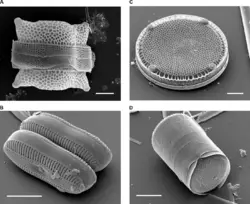
Like plants, algae have cell walls.[4] Algal cell walls contain cellulose and a variety of glycoproteins. The inclusion of additional polysaccharides in algal cells walls is used as a feature for algal taxonomy.
- Manosyl form microfibrils in the cell walls of a number of marine green algae including those from the genera, Codium, Dasycladus, and Acetabularia as well as in the walls of some red algae, like Porphyra and Bangia.
- Xylanes
- Alginic acid is a common polysaccharide in the cell walls of brown algae
- Sulfonated polysaccharides occur in the cell walls of most algae; those common in red algae include agarose, carrageenan, porphyran, furcelleran and funoran.
Other compounds that may accumulate in algal cell walls include sporopollenin and calcium ions.
The group of algae known as the diatoms synthesize their cell walls (also known as frustules or valves) from silicic acid (specifically orthosilicic acid, H4SiO4). The acid is polymerised intra-cellularly, then the wall is extruded to protect the cell. Significantly, relative to the organic cell walls produced by other groups, silica frustules require less energy to synthesize (approximately 8%), potentially a major saving on the overall cell energy budget[5] and possibly an explanation for higher growth rates in diatoms.[6]
Fungal cell walls

There are several groups of organisms that may be called "fungi". Some of these groups have been transferred out of the Kingdom Fungi, in part because of fundamental biochemical differences in the composition of the cell wall. Most true fungi have a cell wall consisting largely of chitin and other polysaccharides.[7] True fungi do not have cellulose in their cell walls, but some fungus-like organisms do.
True fungi
Not all species of fungi have cell walls but in those that do, the plasma membrane is followed by three layers of cell wall material. From inside out these are:
- a chitin layer (polymer consisting mainly of unbranched chains of N-acetyl-D-glucosamine)
- a layer of β-1,3-glucan
- a layer of mannoproteins (mannose-containing glycoproteins) which are heavily glycosylated at the outside of the cell.
Fungus-like protists
The group Oomycetes, also known as water molds, are saprotrophic plant pathogens like fungi. Until recently they were widely believed to be fungi, but structural and molecular evidence[8] has led to their reclassification as heterokonts, related to autotrophic brown algae and diatoms. Unlike fungi, oomycetes typically possess cell walls of cellulose and glucans rather than chitin, although some genera (such as Achlya and Saprolegnia) do have chitin in their walls.[9] The fraction of cellulose in the walls is no more than 4 to 20%, far less than the fraction comprised by glucans.[9] Oomycete cell walls also contain the amino acid hydroxyproline, which is not found in fungal cell walls.
The dictyostelids are another group formerly classified among the fungi. They are slime moulds that feed as unicellular amoebae, but aggregate into a reproductive stalk and sporangium under certain conditions. Cells of the reproductive stalk, as well as the spores formed at the apex, possess a cellulose wall.[10] The spore wall has been shown to possess three layers, the middle of which is composed primarily of cellulose, and the innermost is sensitive to cellulase and pronase.[10]
Prokaryotic cell walls
Bacterial cell walls
- Further information: Cell envelope
Around the outside of the cell membrane is the bacterial cell wall. Bacterial cell walls are made of peptidoglycan (also called murein), which is made from polysaccharide chains cross-linked by unusual peptides containing D-amino acids.[11] Bacterial cell walls are different from the cell walls of plants and fungi which are made of cellulose and chitin, respectively.[12] The cell wall of bacteria is also distinct from that of Archaea, which do not contain peptidoglycan. The cell wall is essential to the survival of many bacteria. The antibiotic penicillin is able to kill bacteria by inhibiting a step in the synthesis of peptidoglycan.[12]
There are broadly speaking two different types of cell wall in bacteria, called Gram-positive and Gram-negative. The names originate from the reaction of cells to the Gram stain, a test long-employed for the classification of bacterial species.[13]
Gram-positive bacteria possess a thick cell wall containing many layers of peptidoglycan and teichoic acids. In contrast, Gram-negative bacteria have a relatively thin cell wall consisting of a few layers of peptidoglycan surrounded by a second lipid membrane containing lipopolysaccharides and lipoproteins. Most bacteria have the Gram-negative cell wall and only the Firmicutes and Actinobacteria (previously known as the low G+C and high G+C Gram-positive bacteria, respectively) have the alternative Gram-positive arrangement.[14] These differences in structure can produce differences in antibiotic susceptibility, for instance vancomycin can kill only Gram-positive bacteria and is ineffective against Gram-negative pathogens, such as Haemophilus influenzae or Pseudomonas aeruginosa.[15]
Archaeal cell walls
Although not truly unique, the cell walls of Archaea are unusual. Whereas peptidoglycan is a standard component of all bacterial cell walls, all archaeal cell walls lack peptidoglycan,[16] with the exception of one group of methanogens.[17] In that group, the peptidoglycan is a modified form very different from the kind found in bacteria.[16] There are four types of cell wall currently known among the Archaea.
One type of archaeal cell wall is that composed of pseudopeptidoglycan (also called pseudomurein). This type of wall is found in some methanogens, such as Methanobacterium and Methanothermus.[18] While the overall structure of archaeal pseudopeptidoglycan superficially resembles that of bacterial peptidoglycan, there are a number of significant chemical differences. Like the peptidoglycan found in bacterial cell walls, pseudopeptidoglycan consists of polymer chains of glycan cross-linked by short peptide connections. However, unlike peptidoglycan, the sugar N-acetylmuramic acid is replaced by N-acetyltalosaminuronic acid,[16] and the two sugars are bonded with a β,1-3 glycosidic linkage instead of β,1-4. Additionally, the cross-linking peptides are L-amino acids rather than D-amino acids as they are in bacteria.[18]
A second type of archaeal cell wall is found in Methanosarcina and Halococcus. This type of cell wall is composed entirely of a thick layer of polysaccharides, which may be sulfated in the case of Halococcus.[18] Structure in this type of wall is complex and as yet is not fully investigated.
A third type of wall among the Archaea consists of glycoprotein, and occurs in the hyperthermophiles, Halobacterium, and some methanogens. In Halobacterium, the proteins in the wall have a high content of acidic amino acids, giving the wall an overall negative charge. The result is an unstable structure that is stabilized by the presence of large quantities of positive sodium ions that neutralize the charge.[18] Consequently, Halobacterium thrives only under conditions with high salinity.
In other Archaea, such as Methanomicrobium and Desulfurococcus, the wall may be composed only of surface-layer proteins,[17] known as an S-layer. S-layers are common in bacteria, where they serve as either the sole cell-wall component or an outer layer in conjunction with peptidoglycan and murein. Most Archaea are Gram-negative, though at least one Gram-positive member is known.[17]
See also
- Bacterial cell structure
- Plant cell
ReferencesISBN links support NWE through referral fees
- ↑ Laurence Moire, Alain Schmutz, Antony Buchala, Bin Yan, Ruth E. Stark, and Ulrich Ryser (1999). "Glycerol Is a Suberin Monomer. New Experimental Evidence for an Old Hypothesis". Plant Physiol. 119: 1137-1146
- ↑ Buchanan and Gruissem, Jones (2000). Biochemistry & molecular biology of plants, 1st ed., American society of plant physiology. ISBN 0-943088-39-9.
- ↑ Wilson, Brayton F. (1984). The Growing Tree, revised ed., Amherst: University of Massachusetts Press, 114-115. ISBN 0-87023-424-2.
- ↑ Sendbusch, Peter V. (2003-07-31). "Cell Walls of Algae". Botany Online. Retrieved on 2007-10-29.
- ↑ Raven, J. A. (1983). The transport and function of silicon in plants. Biol. Rev. 58, 179-207.
- ↑ Furnas, M. J. (1990). "In situ growth rates of marine phytoplankton : Approaches to measurement, community and species growth rates". J. Plankton Res. 12, 1117-1151.
- ↑ Hudler, George W. (1998). Magical Mushrooms, Mischievous Molds. Princeton, NJ: Princeton University Press, 7. ISBN 0-691-02873-7.
- ↑ Sengbusch, Peter V. (2003-07-31). "Interactions between Plants and Fungi: the Evolution of their Parasitic and Symbiotic Relations". biologie.uni-hamburg.de. Retrieved on 2007-10-29.
- ↑ 9.0 9.1 Alexopoulos, C. J., C. W. Mims, & M. Blackwell (1996). Introductory Mycology 4. New York: John Wiley & Sons, 687-688. ISBN 0-471-52229-5.
- ↑ 10.0 10.1 Raper, Kenneth B. (1984). The Dictyostelids. Princeton, NJ: Princeton University Press, 99-100. ISBN 0-691-08345-2.
- ↑ van Heijenoort J (2001). Formation of the glycan chains in the synthesis of bacterial peptidoglycan. Glycobiology 11 (3): 25R – 36R.
- ↑ 12.0 12.1 Koch A (2003). Bacterial wall as target for attack: past, present, and future research. Clin Microbiol Rev 16 (4): 673 – 87.
- ↑ Gram, HC (1884). Über die isolierte Färbung der Schizomyceten in Schnitt- und Trockenpräparaten. Fortschr. Med. 2: 185–189.
- ↑ Hugenholtz P (2002). Exploring prokaryotic diversity in the genomic era. Genome Biol 3 (2): REVIEWS0003.
- ↑ Walsh F, Amyes S (2004). Microbiology and drug resistance mechanisms of fully resistant pathogens.. Curr Opin Microbiol 7 (5): 439-44.
- ↑ 16.0 16.1 16.2 White, David. (1995) The Physiology and Biochemistry of Prokaryotes, pages 6, 12-21. (Oxford: Oxford University Press). ISBN 0-19-508439-X.
- ↑ 17.0 17.1 17.2 Howland, John L. (2000) The Surprising Archaea: Discovering Another Domain of Life, pages 69-71. (Oxford: Oxford University Press). ISBN 0-19-511183-4.
- ↑ 18.0 18.1 18.2 18.3 Brock, Thomas D., Michael T. Madigan, John M. Martinko, & Jack Parker. (1994) Biology of Microorganisms, 7th ed., pages 818-819, 824 (Englewood Cliffs, NJ: Prentice Hall). ISBN 0-13-042169-3.
- Alberts, B., D. Bray, J. Lewis, M. Raff, K. Roberts, and J. D. Watson. Molecular Biology of the Cell, 2nd edition. New York: Garland Publishing, 1989. ISBN 0824036956.
- Alberts, B., A. Johnson, J. Lewis, M. Raff, K. Roberts, and P. Walter. 2002. Molecular Biology of the Cell, 4th edition. New York: Garland Science. ISBN 0815332181.
- Esau, K. 1965. Plant Anatomy, 2nd edition. John Wiley & Sons.
[1]}}
External links
| Organelles of the cell |
|---|
| Acrosome | Chloroplast | Cilium/Flagellum | Centriole | Endoplasmic reticulum | Golgi apparatus | Lysosome | Melanosome | Mitochondrion | Myofibril | Nucleus | Parenthesome | Peroxisome | Plastid | Ribosome | Vacuole | Vesicle |
| ||||||||||||||||||||
Credits
New World Encyclopedia writers and editors rewrote and completed the Wikipedia article in accordance with New World Encyclopedia standards. This article abides by terms of the Creative Commons CC-by-sa 3.0 License (CC-by-sa), which may be used and disseminated with proper attribution. Credit is due under the terms of this license that can reference both the New World Encyclopedia contributors and the selfless volunteer contributors of the Wikimedia Foundation. To cite this article click here for a list of acceptable citing formats.The history of earlier contributions by wikipedians is accessible to researchers here:
The history of this article since it was imported to New World Encyclopedia:
Note: Some restrictions may apply to use of individual images which are separately licensed.
- ↑ Howland, John L. (2000). The Surprising Archaea: Discovering Another Domain of Life. Oxford: Oxford University Press, 69-71. ISBN 0-19-511183-4.
